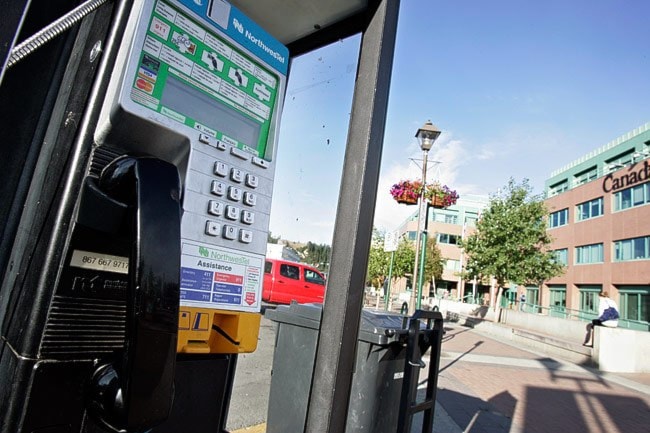Northern pay phones will now cost two quarters instead of one.
But it’s not like Northwestel will be getting rich off of it.
“Pay phones have not returned any profit for a very long time,” said Anne Kennedy, spokesperson for Northwestel.
Even with the 100 per cent rate increase, pay phones will probably still lose money, she said.
“This increase will reduce the loss associated with pay phone service,” said Northwestel president Paul Flaherty in an official release.
But public sympathy is rarely reserved for telecommunications monopolies.
“There’s definitely some people who have raised concerns,” said Kennedy.
“Typically, when the demand decreases in relation to the supply (for any product or service), the price goes down,” scoffed a comment on the CBC website.
Scoffs aside, most of the rate hike’s detractors probably don’t even use pay phones, said Kennedy.
“There’s a whole generation out there who would never consider a pay phone because they have their cellphone,” she said.
Still, the phones remain open.
“In really small communities there’s usually at least one, and two for sure,” she said.
Even the isolated Nunavut community of Sanikiluaq - located in the middle of Hudson Bay - has a Northwestel pay phone.
With the phone earning about $40 per year, it isn’t even worth Northwestel’s while to collect the phone’s coinage.
Instead, the money gets donated to an after-school program.
Post-hike, the phone’s revenues may well jump to $80, but with flights to Sanikiluaq costing upwards of $1,000, the after-school program needn’t worry.
There are 186 pay phones within Whitehorse city limits, said Kennedy.
Located mainly in shops and public facilities, Whitehorse pay phones are elusive after hours.
Vandalism is mainly to blame.
Northwestel last boosted its pay-phone rates in 1985.
Tetris had just been released, Mikhail Gorbachev had just been appointed General Secretary of the Soviet Union, and Canadian northerners suddenly saw the pay-phone fee upped from 10 cents to 25 cents.
Thirteen years later, Northwestel tried to boost the rates again, from 25 cents to 35 cents, but Canadian telecommunications authorities turned them down.
“In most areas of Canada where there is competition, the approved tariff is still $0.25,” read a 1998 CRTC report.
The 25-cent hike brings the Yukon in line with most of the rest of Canada.
In Saskatchewan, Manitoba, Atlantic Canada and all of Canada’s major cities, pay-phone users have long needed to insert two quarters.
Contact Tristin Hopper at
tristinh@yukon-news.com
